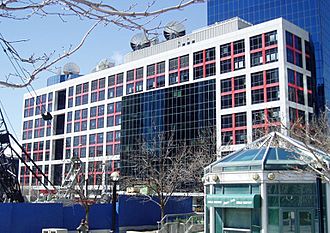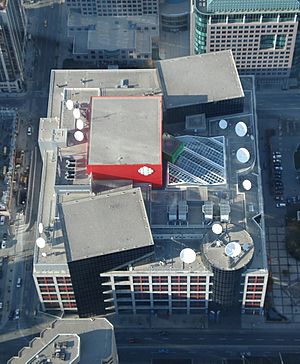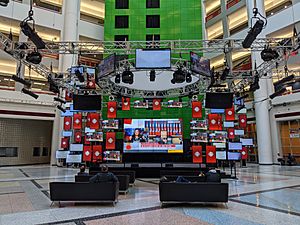Canadian Broadcasting Centre facts for kids
Quick facts for kids Canadian Broadcasting Centre |
|
|---|---|
 |
|
| General information | |
| Location | 205 Wellington Street West Toronto, Ontario M5V 3G7 |
| Current tenants | Rogers Media (eighth and tenth floors only) |
| Construction started | 1988 |
| Completed | 1992 |
| Owner | Canadian Broadcasting Corporation |
| Technical details | |
| Floor count | 13 |
| Floor area | 1,720,000 square feet (160,000 m2) |
| Design and construction | |
| Architect | Philip Johnson |
| Architecture firm | John Burgee Architects (design), Bregman + Hamann Architects (production) |
| Structural engineer | Quinn Dressel Associates |
| Other designers | Barton Myers (Development/Design Guidelines and Outline Specifications) (1985) |
The Canadian Broadcasting Centre is a large building in Toronto, Canada. It is also known as the CBC Toronto Broadcast Centre. This building is the main place where the Canadian Broadcasting Corporation (CBC) creates and sends out its English TV and radio shows. It also has studios for French-language shows made in the area. The building is the main office for the North American Broadcasters Association.
The Canadian Broadcasting Centre is located in downtown Toronto. It is close to other famous places like Union Station, the Rogers Centre, and the CN Tower. You can even reach it through Toronto's underground walkway system called PATH.
Contents
History of the CBC Centre
The Canadian Broadcasting Centre is a 13-storey building. It stands on land where the first Parliament Buildings of Upper Canada once were, from 1832 to 1903. The CBC Centre cost about Cdn$350 million to build. It opened in 1993. Before this, CBC's Toronto operations were in a smaller building on Jarvis Street.
Why the Centre Was Built
The main goal for building this centre was to bring many CBC employees together. Before, they were spread out in over 20 different places across Toronto. The new building also helped the CBC use new technology. This included digital TV and radio, and advanced computer systems. The idea was to prepare the CBC for the 21st century.
Building and Technology
Planning for the centre took more than 12 years. A lot of focus was on how to use new digital technology. This included digital archives and interactive TV. The building's design also considered how to protect its systems from electronic interference. Construction took four years.
When it opened, the Canadian Broadcasting Centre was one of the most advanced broadcast centres in the world. It was a big success because all the staff and systems moved without any break in broadcasting.
Inside the Building
TV shows are made on the upper floors of the building. Some large studios on the roof are used for many programs. Radio shows are produced on the second and third floors. Some of the biggest studios are rented out to other companies. They use them for movies, TV shows, and commercials.
The entire building sits on 3,000 large rubber pads. These pads help stop unwanted noise and vibrations. Because of this, all the studios are in the middle of the building. The centre also has four powerful generators. These can provide power if there is an outage.
The large open space inside the building is called the Barbara Frum Atrium. It is named after a famous Canadian journalist. This space is used for special broadcasts. These include election coverage and episodes of Canadian Antiques Roadshow.
The building has three main radio studios, including the Glenn Gould Theatre. It also has 19 smaller radio production studios. For television, there are three large TV studios and two smaller local TV studios. There are also two all-purpose studios and one national news studio. Local and national shows for CBC's TV and radio networks are made here.
Former CBC Museum
The building used to have a CBC Museum on the first floor. This museum showed items from the CBC's history. Exhibits included the "Tickle Trunk" from Mr. Dressup and puppets from Sesame Park. The museum closed in 2017. Its collection was moved to Ingenium, which runs Canada's national science and technology museums.
Future of the Building
In 2015, the CBC announced plans to sell the building. They would then rent back parts of it. This is because the CBC leases many parts of the building. Also, new technologies mean they need less space and fewer staff.
The main centre for CBC's French-language shows is Maison Radio-Canada in Montreal. The main corporate office for the CBC is in Ottawa.
Safety and Security Measures
The Canadian Broadcasting Centre has strong security measures. It is an important building, so safety is always a top concern.
Past Security Incidents
The building has been a focus of security attention in the past. In 2010, during a large international meeting in Toronto, the area around the building was secured. Employees had to stay inside for safety during parts of the event. Security services have also helped identify suspicious items near the building. For example, in 2015, a non-dangerous item resembling a military shell was found in the archives. This led to a temporary evacuation for safety checks. Security has also been increased at times due to online threats.
Television Studios at the Centre

The Canadian Broadcasting Centre has several large television studios. Many popular shows are filmed here.
- Studio 40 – This is the largest studio in Canada built for multi-camera TV shows. It is on the 10th floor and has a very high ceiling. Shows like Dragons' Den and Canada's Smartest Person have been filmed here.
- Studios 41 and 42 – Also on the 10th floor, these two studios are very similar. Many CBC comedy shows have used them, such as Air Farce Live and Rick Mercer Report. Studio 41 is rented by Sportsnet for its NHL hockey coverage.
- Studios 43 and 65 – These smaller studios are on the 6th floor. They are used for talk shows and lifestyle programs like George Stroumboulopoulos Tonight. The classic children's show Mr. Dressup was filmed here after the centre opened.
- Studio 50 – This studio is used for CBC's 24-hour news channel, CBC News Network.
- Studio 55 – This is the home of CBC's main national news program, The National.
- Studio 73 – Located on the 5th floor, this studio has a large green screen. It is used to film the hosted parts of CBC Kids shows.



